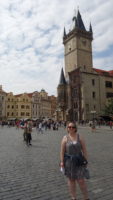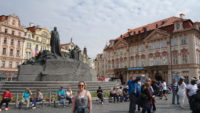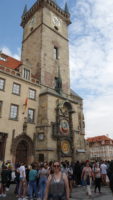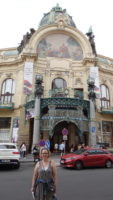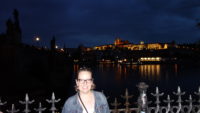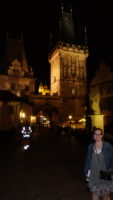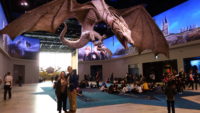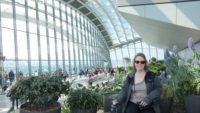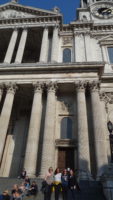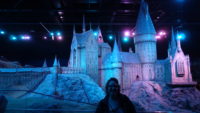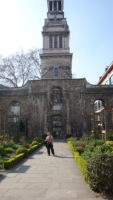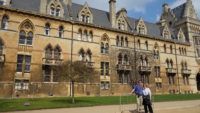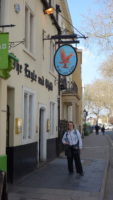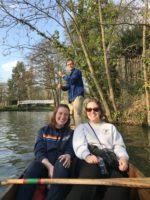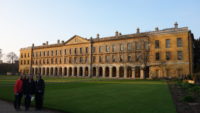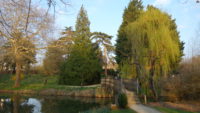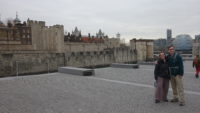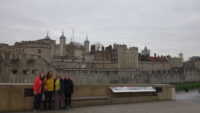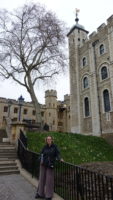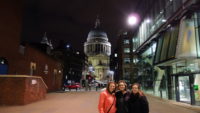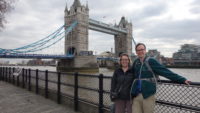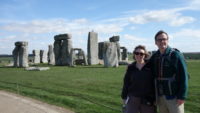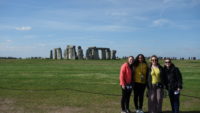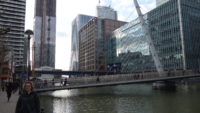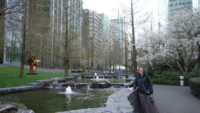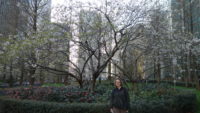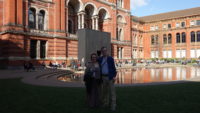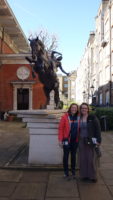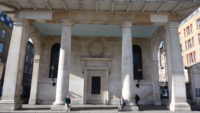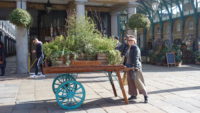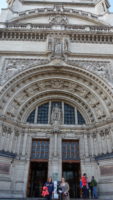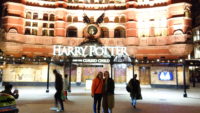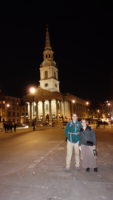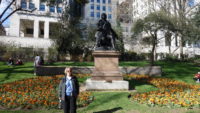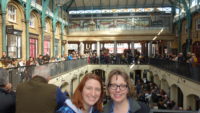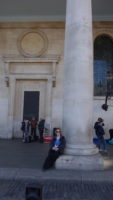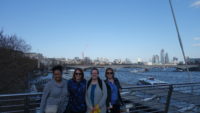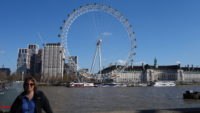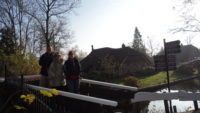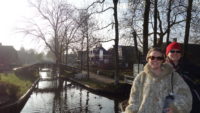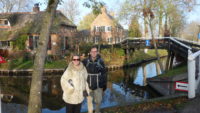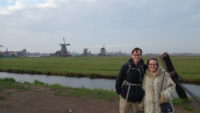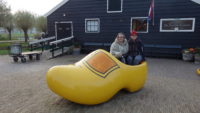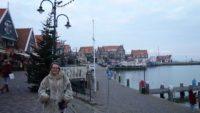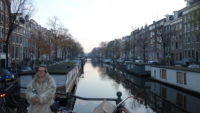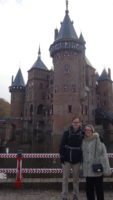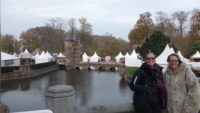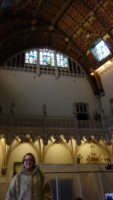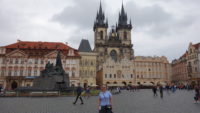 We in the United States do not have a great sense of long history; it has not sunk down and become part of who we are. We celebrate historic buildings built in 1901 and put up “History happened here!” signs celebrating the dedication of a “History happened here!” sign in 1965, and these are fine – I find them interesting.
We in the United States do not have a great sense of long history; it has not sunk down and become part of who we are. We celebrate historic buildings built in 1901 and put up “History happened here!” signs celebrating the dedication of a “History happened here!” sign in 1965, and these are fine – I find them interesting.
Then you hit Europe. Where the oldest operating synagogue in all of Europe, built around 1290, is known as (really), “the Old New Synagogue.” Since there was an even older synagogue around when the newer one was built, it became the New Synagogue. Then, after a few hundred years, it became the Old New Synagogue. When your “new” synagogue is over seven hundred years old, you have some history behind you.
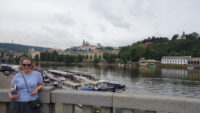 After a too-early wake-up alarm around 7:15 am, on day two of jet lag, we had breakfast and then went to the old city, to the old Jewish quarter, where we met up with a Jewish tour guide and three other Americans for a three-plus-hour walk through the remains of the Jewish neighborhood of Prague.
After a too-early wake-up alarm around 7:15 am, on day two of jet lag, we had breakfast and then went to the old city, to the old Jewish quarter, where we met up with a Jewish tour guide and three other Americans for a three-plus-hour walk through the remains of the Jewish neighborhood of Prague.
I say “what remains” because in the 1860s, Jews were granted full citizenship rights by the Austro-Hungarian Empire as a larger part of concessions to minority groups to help quell rebellions. Since Jews were no longer required to live in a segregated neighborhood, the wealthy families moved out into the larger city, leaving the area to the Jewish poor, and later the poor in general. By 1900, the area was a slum, and the city razed most of it to make way for new buildings. They did leave a few synagogues and the old Jewish cemetery behind, as well as a few other important buildings.
We started at the Old New Synagogue, which is an Orthodox congregation. That means, in part, that women are segregated from the men who sit in a rectangle around the cantor who chants the service. The women watch and listen through small windows in the interior walls. I was surprised at how small the main room is – about the size of a large school classroom. It is also a reminder of how much time has passed that to get into the synagogue, you need to go down four or five steps; the synagogue was build at street level, meaning that the surrounding area has been built up that much over seven hundred years. And yet as recently as 2002, the building and environs were flooded by the Vltava River up to three or four feet deep.
We next visited Maisel Synagogue, which is no longer an active place of worship, but instead is a museum that tells the story of Jews in the Czech region. Many of the objects were given to the Prague Jewish community for safekeeping ahead of serious persecution during World War II. There was an excellent computer-animated movie of how the old Jewish quarter looked in the 1880s; a librarian made an accurate 3-D paper model of the city of Prague at the time, and remarkably, the model still survives, and became the basis for this short film.
We went on to Pinkas Synagogue, which is also no longer active. Instead, it has been turned into a very moving memorial to the almost eighty thousand Czech Jews who were murdered in camps by the Nazis. The name of every known victim is neatly handwritten on the walls of the building, while recorded voices quietly read the names of the dead over speakers. In addition, there was a small room filled with artwork drawn by children at a holding camp called Terezin. The children were allowed to have an art class, and some of the teachers hid the work safely away. It is hard to imagine the life the children led that brought them to draw things like being thrown out of school, or drawing a hanging of a Jewish man, or drawing pictures of the trains that took people away. It was at this synagogue that we learned that the Nazis required local Jewish leaders to pick which Jews would be rounded up; the Nazis asked for a certain number, and then the local council had to provide that many Jews. It was chillingly cruel.
Pinkas exits though the old Jewish cemetery from around 1400 to1700. There are something like twelve thousand headstones, but an estimated forty thousand people are buried there, as people were buried on top of older graves because of space constraints. Somehow, this cemetery was left alone by both the Nazis and the Communists.
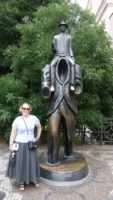
The last synagogue we visited was Klausen Synagogue, which now houses a museum explaining Jewish holidays and traditions. I know a fair amount about Jewish holidays and customs from the Bible, but there are a lot of extra-Biblical traditions that exist. For instance, I had no idea there was a “Days of Sorrow” centered on remembering the destroyed temple from 70 AD and the one before that in 570 BC. It would be an interesting place to visit when we have more time someday.
We finished the now-almost-four-hour tour by walking to a statue commemorating Franz Kafka, and then on to seeing the outside of the Spanish Synagogue, which is under renovation for almost two years. Our guide showed us pictures from inside, and it is beautiful – heavily decorated in the Moorish style of geometrical shapes with bright colors.
The tour was very good, and our guide was very patient with all of our questions. It was a morning well spent, even on only a few hours’ sleep.
Since it was almost 2:00, we walked over to near the Charles Bridge, where we had lunch in a small coffee shop. Refreshed by food and rest, we walked back to the bridge, where we climbed the tower on the Old Town side of the bridge. It is a solid climb up about 150 stairs, but the views of the old town, the bridge, and Prague Castle were all worth it. In addition, I’m usually terrified of heights, but the windows that looked out from the ramparts were high enough that I felt safe.
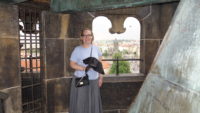 The forecast had called for rain all day today, but we had only been rained on for short periods during our walking tour. It began to rain as we crossed the bridge to the castle-side tower, where we climbed up that one as well. That tower was much less crowded than the twin across the bridge; I’m not sure if it was because of the rain or because the crowds seem to hang out on the Old Town side of the bridge. Either way, it made for a pleasant viewing platform, even in the light rain. We retreated inside the tower for a few minutes when I saw some nearby lightning, but that passed, so we went back outside.
The forecast had called for rain all day today, but we had only been rained on for short periods during our walking tour. It began to rain as we crossed the bridge to the castle-side tower, where we climbed up that one as well. That tower was much less crowded than the twin across the bridge; I’m not sure if it was because of the rain or because the crowds seem to hang out on the Old Town side of the bridge. Either way, it made for a pleasant viewing platform, even in the light rain. We retreated inside the tower for a few minutes when I saw some nearby lightning, but that passed, so we went back outside.
We walked back across the bridge and headed back into the Old Town. It rained hard for a few minutes along the way, but then stopped for the rest of the evening. Having a total of about twenty minutes of rain in a whole day of touring was a real blessing when we thought it was going to rain all day.
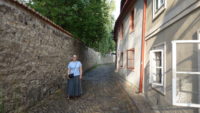 We jumped on the number 22 tram to take a scenic ride up to the castle area. Sitting while touring was a welcome change. We got off near the top of the hill to wander in a quiet neighborhood area, where we only saw four or five people, none of whom seemed to be tourists.
We jumped on the number 22 tram to take a scenic ride up to the castle area. Sitting while touring was a welcome change. We got off near the top of the hill to wander in a quiet neighborhood area, where we only saw four or five people, none of whom seemed to be tourists.
We took the same tram back to the center, where we ate a quick meal at a sandwich shop on the main shopping drag. It was not quaint, but it was getting late, and it seemed like a good idea to get back to our hostel to try to get a full night’s sleep – I’m in charge tomorrow, and of course I only have vague ideas of what we might do. I’ll need to sleep on it.
